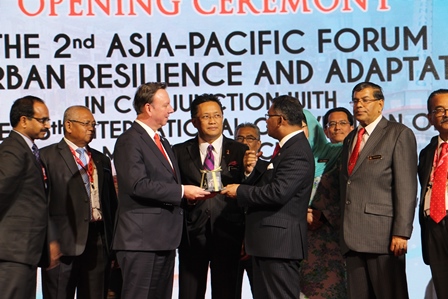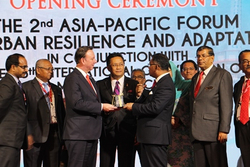Resilient Cities Asia-Pacific 2016 Opens with Assessment of “Milestone” 2015

The 2nd Resilient Cities Asia-Pacific Congress was officially opened today in Melaka, Malaysia by Datuk Seri Ir. Haji Idris Haron, the Chief Minister of Melaka. Haron highlighted Melaka’s credentials as a resilient city, pointing out its goal of becoming a Green Technology City State by 2020 and its alignment with the national target of reducing CO2 emissions by 40 percent by 2020. As part of this effort, Melaka State – with the help of ICLEI – has compiled its first greenhouse gas emissions inventory.
Earlier in the day, a plenary session considered the implications of UN outcomes in 2015, including the Paris Agreement and the Sustainable Development Goals (SDGs), for local and subnational governments.
Facilitating the panel, ICLEI Secretary General Gino Van Begin explained that ICLEI had worked hard since 2007 to obtain international recognition for local sustainability efforts. 2015 had been a “milestone”, he added, as nations had recognized the need to work with different levels to address the “enormous challenges that are in front of us”: climate change, poverty, economic crises, rapid urbanization, overuse of natural resources, and energy dependency. All of these issues, he said, could only be tackled through partnerships.
Panelists emphasized that global agreements are meaningless unless they have relevance for the concerns of local governments, like flooding in cities where upgrades for old neighborhoods are expensive. Timothy Wilcox of UNISDR highlighted how the Sendai framework can help with this, as it explicitly acknowledges the importance of local governments, and can serve as a tool to gain recognition from national governments. Commitments must also be made relevant to citizens, explained Donovan Storey of UN ESCAP, which requires individuals to be strong ambassadors for the international agreements.
The international agreements offer a chance for governments to reflect on strategies to pursue more general development agendas. Rajesh Sharma of UNDP emphasized the importance of integration and the breaking of silos for resilient development, with the SDGs providing a further incentive. However, for this to happen, systemic changes would be required within international agencies and national governments, with greater encouragement for local governments to implement ambitious projects. Capacity building is also necessary, panelists said, especially within mid-tier local governments, which are sometimes passed over by donors.
It was also important, Mariko Sato of UN-Habitat explained, for local governments not to start from scratch but to see which existing local initiatives could be placed within the international frameworks, attracting support from agencies and governments involved. Melaka is one example of this, Rahamat Bivi Yusoff added, with its participation in the Indonesia-Malaysia-Thailand Growth Triangle (IMT-GT), which accelerates economic development in less developed provinces.
Following the opening plenary, the first day of Resilient Cities Asia-Pacific featured a number of parallel sessions on a range of topics. To read our blog highlights, please click here.



